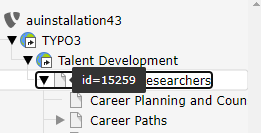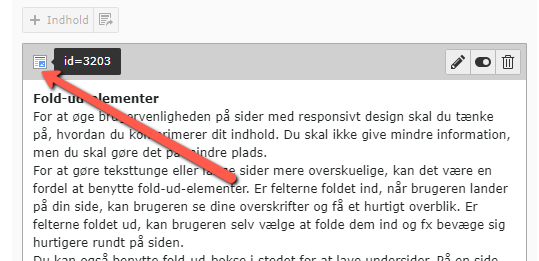Find the ID number of a page
All pages in TYPO3 have a unique page number. We refer to the page number both as page-id or pid (page id). You can find the page number both in the backend and frontend, or with a bookmarklet.
Find the page number in the backend
In the backend, you can find the page number by hovering over the page icon in the page tree. If you need the page number for TYPO3 support, be sure to also note which TYPO3 installation the page is on.

Find the page number at the bottom of a page
At the bottom right corner of AU's websites, you will find the page number and the installation number.
![[Translate to English:] Sidenummer og installationsnummer Screenshot: AU](/fileadmin/_processed_/7/5/csm_se_pid_055d75c870.png)
The page number is not immediately visible but appears when you hover the mouse over it (aim about 1 cm from the right margin and 0.5 cm above the bottom of the page).
It’s easiest to copy the number by double-clicking on it to highlight it, then press Ctrl+C.
Find element number
You might need to know the ID number of a page element if, for example, you want to create a link to it. Hover your mouse over the element's icon, and the ID number will appear as shown (id=3203).
See how to link to elements:

Add a parameter to the page URL
Add'?id=150171' to any TYPO3 page URL in the address bar and press Enter. Try this one: https://typo3.au.dk/?id=1634 (the page ID for this guide is 1634)
It's difficult to remember, so it's recommended to create a bookmark for this URL addition for future use. See the instructions in the following section.
Create a button in the bookmark bar
It can be very helpful to have a button in your browser's bookmarks menu that allows you to quickly display the page ID (pid) and other information for any TYPO3 page.
It's easiest to do this by right-clicking on it 'bookmarklet-link' and choosing to create a bookmark.
Remember to choose to save the bookmark to the bookmarks bar so it is easily accessible as a button.
A bookmarklet is a link with a snippet of JavaScript. This bookmarklet appends the parameter described in the previous section to the currently displayed URL.
You can then view information about any TYPO3 page by simply clicking the button on the bookmarks bar from any of our TYPO3 pages.